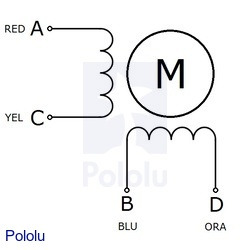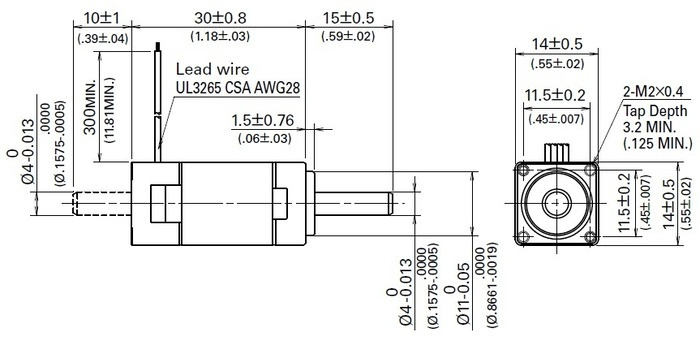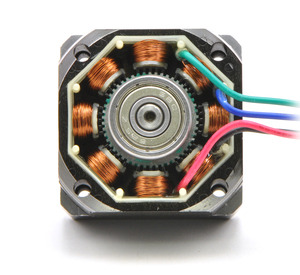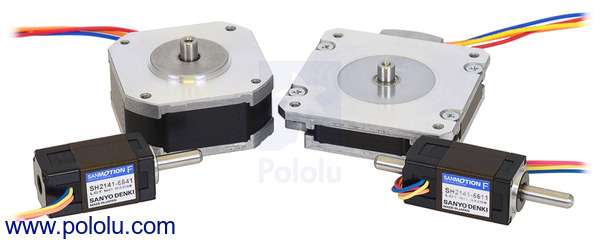This tiny, double shaft bipolar stepping motor from Sanyo has a 1.8° step angle (200 steps/revolution). Each phase draws 300 mA at 6.3 V, allowing for a holding torque of 66 g-cm (0.92 oz-in). With a weight of 28 g, this is the smallest stepper motor we carry.
Special Order
Shipping from $9.90
+10 more from our supplier in 7-10 days
Our Code: SKU-003153
Supplier Link: [Pololu MPN:2295]
This tiny, double shaft bipolar stepping motor from Sanyo has a 1.8° step angle (200 steps/revolution). Each phase draws 300 mA at 6.3 V, allowing for a holding torque of 66 g-cm (0.92 oz-in). With a weight of 28 g, this is the smallest stepper motor we carry.
 |
Sanyo bipolar stepper motor wiring diagram. |
|---|
This tiny bipolar stepping motor from Sanyo has a 1.8° step angle (200 steps/revolution) and is available with a single shaft or double shaft. Each phase draws 300 mA at 6.3 V, allowing for a holding torque of 66 g-cm (0.92 oz-in). The motor has four colour-coded wires terminated with bare leads: red and yellow connect to one coil; orange and blue connect to the other. It can be controlled by a pair of suitable H-bridges (one for each coil), but we recommend using a bipolar stepper motor driver or one of our Tic Stepper Motor Controllers. In particular, the Tics make control easy because they support six different interfaces (USB, TTL serial, I²C, RC, analogue voltages, and quadrature encoder) and are configurable over USB with our free configuration utility.
Our 4 mm universal mounting hub can be used to mount objects on the stepper motor’s 4 mm-diameter output shaft.
More specifications are available in the datasheet (125k pdf).
The following diagram shows the stepper motor dimensions in mm. This motor is 30 mm in length. The output shaft has a length of 15 mm and a diameter of 4 mm. The second shaft on the dual version has a length of 10 mm and a diameter of 4 mm. This shaft works with our 4 mm universal mounting hub.
 |
  |
The inside of a bipolar stepper motor (SOYO NEMA 14-size). |
|---|
Stepper motors are generally used in a variety of applications where precise position control is desirable and the cost or complexity of a feedback control system is unwarranted. Here are a few applications where stepper motors are often found:
 |
Sanyo stepper motors; from left to right: 14mm single shaft, 42×18.6mm, 50×11mm, 14mm double shaft |
|---|
Note: Sanyo Denki calls these products the “SANMOTION F2 Small Size 2-Phase Stepping Motor Models SH2141-5541 (or SH2141-5541P)” and “SH2141-5511 (or SH2141-5511P)”. The one ending in 5541/5541P is the part number for the single shaft version while the one ending in 5511/5511P is the part number for the double shaft version.
| Size: | 14mm square × 30 mm1 |
|---|---|
| Weight: | 28 g |
| Shaft diameter: | 4 mm |
| Shaft type: | Double shaft |
|---|---|
| Current rating: | 300 mA2 |
| Voltage rating: | 6.3 V |
| Model: | SH2141-5511 or SH2141-5511P |
| Holding torque: | 0.92 oz·in |
| Steps per revolution: | 200 |
| Resistance: | 21 Ohm2 |
| Inductance per phase: | 4.2 mH |
| Number of leads: | 4 |
| Lead length: | 30 cm |
| Encoders?: | N |
Yes. To avoid damaging your stepper motor, you want to avoid exceeding the rated current, which is 600 mA in this instance. All of our stepper motor drivers let you limit the maximum current, so as long as you set the limit below the rated current, you will be within spec for your motor, even if the voltage exceeds the rated voltage. The voltage rating is just the voltage at which each coil draws the rated current, so the coils of your stepper motor will draw 600 mA at 3.9 V. By using a higher voltage along with active current limiting, the current is able to ramp up faster, which lets you achieve higher step rates than you could using the rated voltage.
If you do want to use a lower motor supply voltage for other reasons, consider using our DRV8834 or STSPIN-220 low-voltage stepper motor drivers.